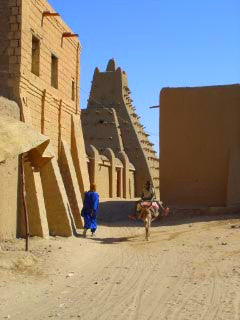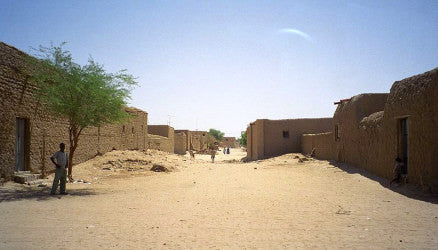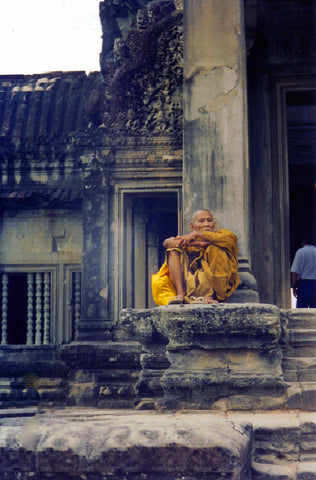Your Cart is Empty
Free Shipping for orders over $49 in Australia, $199 IN NEW ZEALAND/USA/CANADA AND $249 REST OF THE WORLD
Free Shipping for orders over $49 in Australia, $199 IN NEW ZEALAND/USA/CANADA AND $249 REST OF THE WORLD
Add description, images, menus and links to your mega menu
A column with no settings can be used as a spacer
Link to your collections, sales and even external links
Add up to five columns
Add description, images, menus and links to your mega menu
A column with no settings can be used as a spacer
Link to your collections, sales and even external links
Add up to five columns
Where Would You Like to Go Today: Timbuktu, Legendary City of Gold
by Linda Heaphy May 10, 2017
The mosque
In the 14th Century CE, stories were circulating through the civilised world about a fabled city in the Saharan Desert where the streets were paved with gold.
Founded in the 10th Century CE by nomadic Tuaregs as a seasonal settlement, Timbuktu quickly established itself as North Africa's major trading post and grew to become a key city in several successive empires in the region. By the 14th century Timbuktu was part of the mighty Malian empire.

Emperor Musa
Emperor Musa, called the Magnificent and 10th dynastic ruler of the Kingdom of Mali, set out on a famous pilgrimage to Mecca in 1324. He was accompanied by a caravan staffed with 50,000 men and a personal retinue of 12,000 slaves, all of whom were richly dressed in brocades and silks. But it was the hundreds of kilos of gold they carried and distributed to all and sundry along the way that truly awakened the world to the wealth of North Africa. Soon word spread to the cities of the Middle East and of Europe that the streets of Timbuktu were literally paved with gold and this story continued to grow over successive centuries to almost mythical proportions. And in fact the city was fabulously wealthy. Gold mined in nearby Guinea was exchanged in Timbuktu for something equally precious...salt. In chronically short supply in sub-Saharan Africa, salt was literally worth its weight in gold, used not only as flavouring for food but as a preservative and most importantly as a vital dietary supplement.

Timbuktu street with mosque at end
At the beginning of the 19th Century, no Westerner had ever laid eyes on the "lost" city of Timbuktu. In fact the city turned out to be unlucky for many of the Europeans who tried to discover it. In 1788 a group of Englishmen formed the African Association and sponsored a young Scottish adventurer named Mungo Park, who made two trips in search of the Niger River and Timbuktu. It's thought that Park successfully reached the city on his second attempt in 1805 after suffering the loss of almost his entire party to hostile locals, but drowned shortly after leaving it without having the chance to report his findings. In 1824, the French Geographical Society offered a 10,000 franc prize to the first non-Muslim to reach the city and return with an account of it. A Briton, Major Alexander Laing, set out to claim the prize in 1826. Believing the journey would take 8 weeks to complete, it took him the better part of a year to make the trip across the Sahara by caravan. Before he reached Timbuktu his retinue was attacked by hostile Tuaregs, and he completed his journey with terrible injuries. It's believed he found the city and actually lived there for a month, however on setting out for home he was attacked again by Tuaregs frightened of European intervention, and this time was beheaded. Finally a Frenchman René Caillié, travelling alone disguised as Muslim, arrived at Timbuktu in 1828; he was able to safely return and claim the prize. But the legendary riches of Timbuktu were long gone: Caillié described the city as a small and unimportant village made up of mud brick houses and...there was no sign of any gold.
What caused the decline of this once prosperous city, trading capital of North Africa and the jewel in the crown of three empires that spanned 400 years of history? In 1592 the town was sacked by the Sultan of Morocco, who appropriated the city's gold and had it melted down into coinage for his own empire. Some of these coins may still be found today in the hands of collectors and speciality coin sellers throughout the world.
The fabled gold is long gone and the Guinea mines are all but exhausted, but there is another kind of gold in Timbuktu today. During the heyday of the city, in the early 15th century, a number of Islamic institutions were established in Timbuktu, and their legacy is the estimated 1.5 million books and manuscripts they left behind. It's believed that these were buried as protection from thieves and fortune hunters and to date only 300,000 have been rediscovered - and most of these are in an advanced state of decay, awaiting preservation at the hands of a dedicated team of restorers funded by the Malian Government and UNESCO.
Today you can visit Timbuktu, although it remains as Caillié described it: a small and impoverished town of mud brick buildings and ubiquitous domed bread ovens that can be walked over in the space of an hour. All but one of its streets is made of sand. Its reputation however, has caused an international airport to be built there and a small tourist industry exists to cater to visitors. Three historically significant mud brick mosques may be found within it's walls, remnants of glory days, and there is a museum, terraced gardens and a water tower. Timbuktu is also listed as a UNESCO World Heritage Site. For further information about Timbuktu and what to do once you get there, visit the Wikitravel site.

What you see when you get there: an empty street in Timbuktu.
Photo credit: Ranveig
Leave a comment
Comments will be approved before showing up.
Also in Travel

Where Would You Like to go to Today: Kashgar's Hotel Classification System
by Linda Heaphy May 22, 2017
Read More Articles
About the Author
- Linda has a Honours degree in Marine Biology and a PhD in Ecology from the University of NSW, Australia. She has travelled extensively and is a passionate writer on subjects as diverse as the role played by women throughout history, tribal communities and their customs, symbology and ethnology, talismans and their history. Occasionally she also writes about her travel experiences, her new life on a 25 acres in the Northern Rivers region of northern Australia and her black miniature poodle Phoenix. She is currently writing her first book on talismans.
About Us
-
The Kashgar Philosophy

Kashgar began through a love of travel.
In 1989 my father Bernard packed in his house painting business and set off for two years on a backpacking trek to the remotest corners of the world. When he finally arrived in the oasis city of Kashgar, China, he was so impressed with its history that he decided to start a new life collecting and selling exotic goods from all over the world. For 2000 years the legendary city of Kashgar was a melting pot of ideas and a key trading post on the historic Silk Road. It was this unique combination of philosophy and trade that my father wanted to recreate at home.
Starting in markets in 1991, he opened his first store in the Sydney suburb of Newtown in 1994. I gave up my own career as a government scientist to join him in 2000 and soon convinced my partner Ian to join us in what was to become the Family Business.
Today our version of Kashgar stocks a hugely diverse range of furniture, rugs, textiles, antiques, handicrafts and jewellery sourced from over twenty different countries including India, Nepal, Tibet, China, Thailand, Burma, Laos, the Philippines, Vietnam, Mexico, Peru, Turkey, Palestine, Syria, Afghanistan and Turkmenistan. Our collection includes contemporary and tribal silver and gold jewellery, a unique range of headhunting curios, antique Buddhist relics and a collection of one-off necklaces, earrings and bracelets that I design and create myself using the beads and jewellery making techniques of ethnic minorities from around the globe.
Kashgar is a philosophy as well as a store. We are committed to supporting traditional artisans and small village communities by selling authentic handcrafted goods which are personally collected by us. By supporting traditional methods of design and production we hope to encourage local cottage industries which have a low impact on the environment and help ethnic minorities maintain their self-sufficiency into the 21st Century. We are particularly committed to assisting women around the world and to this end have worked with several organisations including the Hua Bin Women's Union of Vietnam, the East Timorese Women's Association and Tikondane in Zambia. Time honoured means of craftsmanship and traditional ways of life are disappearing as people all over the world give up their identity in favour of jeans and T-shirts. We see our trade as a means of staving off the inevitable encroachment of the 21st century, assisting communities to decide for themselves which parts of the western world they wish to incorporate (medicine, education) and which they wish to reject (prostitution, drug production, begging and servitude to warlords). We encourage our customers to think of the handicrafts and artifacts they buy from us as an investment: a piece of history and a way of life that may soon be gone forever.
Kashgar has recently closed its retail outlet and gone completely online.
In the past our pieces appeared in many movies including The Hobbit, Mission Impossible 2, Queen of the Damned, Scooby Doo, Moulin Rouge and Wolverine, and in many televisions series, as well as in plays, commercials and exhibitions. We've found special pieces for individual customers as well as for film sets, event management companies, hotels, businesses, consulates and embassies. The uniqueness of our stock means that we are also very appealing to interior and fashion designers with a taste for the exotic.
There is something for everyone at Kashgar - collectors, the curious, those looking for a special present or for something unique to adorn the home. Most of our items are one-off specialties; other pieces we only stock in small quantities so as to continuously offer a wide and ever-changing range of interesting products. We are also packed with ideas for decorating home and work premises that will challenge your established concepts of design and storage.

Please enjoy - Linda Heaphy
Become a Kashgar nomad and join our mailing list...
Sign up to get the latest on sales, new releases and more …





